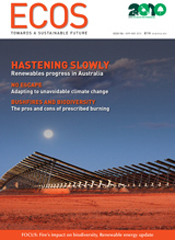
|
Published:
Mapping native vegetation loss in the Wet Tropics
From fog rising above the canopy, to fungi bursting from the forest floor and pandanus fringing the sea, native vegetation in Australia’s Wet Tropics creates endless images of natural beauty and is an important biodiversity asset.

|
| Native vegetation in Australia’s Wet Tropics provides ecosystem services that have cultural, economic and environmental benefits. |
Belying the pristine appearance of many areas, native vegetation over much of the Wet Tropics has been fragmented by historic land use. Biodiversity has continued to decline despite increased scientific understanding and major environmental investment in the area.
‘Native vegetation in the Wet Tropics provides multiple production and environmental benefits for industry and the wider community,’ explains Dr Petina Pert of CSIRO. ‘It plays a key role in biodiversity and water quality maintenance, salinity control, carbon sequestration and commercial production. These multiple values of vegetation present major challenges to policy makers.
‘What we need is a clear understanding of the current condition of native vegetation in the area. This is fundamental to achieving sustainable use of the Wet Tropics by industries and communities, and also for informing policy, both for North Queensland and nationally.’
An integrated report on the extent and condition of native vegetation and biodiversity in the Wet Tropics will be published by CSIRO in June this year. The study is the first to take stock of the trend of native vegetation condition and losses, both inside and outside the World Heritage Area.
‘Our study found that some progress has been made towards halting the loss of biodiversity but the status and trend of most vegetation condition is a concern,’ says Dr Pert.
‘Pest species also continue to pose a major threat to biodiversity and the natural beauty of the area,’ she says.
Funded by the Australian Government’s Marine and Tropical Sciences Research Facility, the study built on the National Carbon Accounting System’s satellite-derived forest dataset to measure changes in the extent and condition of native vegetation across the Wet Tropics from 1972 to 2006.
‘NRM (Natural Resource Management) plans for the Wet Tropics have set a target of no net loss of native vegetation area,’ says Dr Pert. ‘We found that only the Wet Tropics World Heritage Area has remained steady, with no change between 1988 and 2006.’
The Tully and Herbert subregions have lost the highest proportion of native vegetation since 1988 (15 per cent and 18 per cent respectively) and could be priority areas for revegetation.
‘Over the shorter period of 2004 to 2006 that was reported for the Wet Tropics NRM body Terrain NRM, the South Johnstone catchment had the highest relative loss of native vegetation (2 per cent). The Murray and North Johnstone catchments also lost areas of native vegetation during this time.’
Dr Pert explains that a lack of coordinated data collection and reporting arrangements is limiting the ability to report on biodiversity condition and resources.
‘An ongoing monitoring and data system is a high priority if Australia is to measure biodiversity status and trends and make sound investments in the environmental assets of the Wet Tropics.’
More information:
Dr Petina Pert, CSIRO Sustainable Ecosystems,
Petina.Pert@csiro.au



